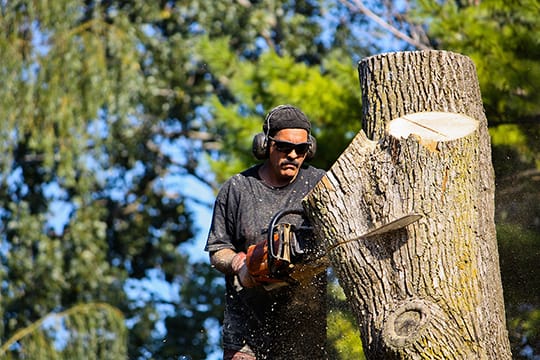When Does a Tree Need Removal?
There are several reasons why a tree in Port Charlotte might need to be removed:
Safety Hazards: Dead, diseased, or storm-damaged trees pose a threat to property and people. Dead or diseased branches can fall unexpectedly, while damaged roots can destabilize structures.
Overgrowth: Trees can grow too close to power lines, buildings, or other structures, requiring removal to prevent damage or safety risks.
Tree Species: Some invasive species like melaleuca trees can disrupt native ecosystems.
Lot Clearing: If you're building a new structure or landscaping your property, removing unwanted trees might be necessary.

Tree Removal Process: From Permits to Cleanup
The process of tree removal generally consists of these steps:
- Contact a Licensed Arborist: An arborist can assess the tree's health and recommend the best course of action, including removal if necessary. They can also help navigate the permitting process, which may be required by the City of Port Charlotte depending on the size and location of the tree.
- Hire a Reputable Tree Service: Look for a company with experience, insurance, and good local reviews.
- Removal and Cleanup: The tree service will safely remove the tree, including any necessary sectioning for large trees.
- Stump Removal or Grinding: Stumps can be unsightly and create tripping hazards. Grinding reduces the stump to mulch, while removal involves digging it out entirely.

Stump Removal vs. Grinding: Choosing the Right Option
Both stump removal and grinding have their advantages:
Stump Removal: This is ideal if you plan to replant in the same location or want a completely clear area. However, it's a more invasive process and leaves a larger hole to be filled.
Stump Grinding: This is less expensive and leaves minimal disruption to the surrounding landscape. However, the ground may settle over time, requiring additional mulch.
Discuss your options with your chosen tree service to determine the best solution for your needs.

Types of Trees Often Removed in Port Charlotte
Some tree species are more commonly removed in Port Charlotte than others:
- Australian Pines: These fast-growing trees have invasive root systems and weak branches, making them prone to falling during storms.
- Cabbage Palms: While beautiful, these palms can become overgrown and require removal if they crowd structures or power lines.
- Sick or Diseased Trees: Trees infected with diseases like laurel wilt or Ganoderma can pose a threat to nearby healthy trees and need to be removed.
- Oak Trees: While majestic, live oaks can grow very large and require removal if they become a hazard to structures or power lines.
- Remember, it's always best to consult an arborist to determine the best course of action for your specific tree situation.
Emergency Tree Removal After Storms and Hurricanes
Florida's tropical climate makes it prone to storms and hurricanes. These can cause significant tree damage, requiring emergency removal. Here's what to do:
- Ensure Safety First: Don't approach downed power lines or attempt to remove large trees yourself.
- Contact Your Local Emergency Services: They can assess the situation and may handle the removal of large, hazardous trees.
- Contact a Tree Service: A reputable tree service can remove smaller debris and ensure the remaining trees are safe.
Hurricane Preparedness: Mitigating Tree Risks
Taking proactive steps before a storm can minimize damage to your property and trees:
Have Your Trees Assessed by an Arborist: They can identify weak branches and recommend trimming or removal to reduce the risk of falling limbs during storms.
Thin the Canopy: Removing some branches allows wind to pass through more easily, reducing the risk of the entire tree toppling over.
By following these tips, you can ensure your Port Charlotte property is prepared for hurricane season.

